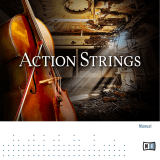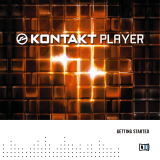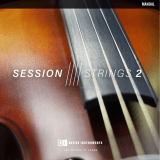Page is loading ...

Manual

The information in this document is subject to change without notice and does not represent a
commitment on the part of Native Instruments GmbH. The software described by this docu-
ment is subject to a License Agreement and may not be copied to other media. No part of this
publication may be copied, reproduced or otherwise transmitted or recorded, for any purpose,
without prior written permission by Native Instruments GmbH, hereinafter referred to as Native
Instruments.
“Native Instruments”, “NI” and associated logos are (registered) trademarks of Native Instru-
ments GmbH.
Mac, Mac OS, GarageBand, Logic, iTunes and iPod are registered trademarks of Apple Inc.,
registered in the U.S. and other countries.
Windows, Windows Vista and DirectSound are registered trademarks of Microsoft Corporation
in the United States and/or other countries.
All other trade marks are the property of their respective owners and use of them does not im-
ply any affiliation with or endorsement by them.
Document authored by: Gero Baier
Software version: 1.0 (02/2015)
Special thanks to the Beta Test Team, who were invaluable not just in tracking down bugs, but
in making this a better product.
Disclaimer

NATIVE INSTRUMENTS GmbH
Schlesische Str. 29-30
D-10997 Berlin
Germany
www.native-instruments.de
NATIVE INSTRUMENTS North America, Inc.
6725 Sunset Boulevard
5th Floor
Los Angeles, CA 90028
USA
www.native-instruments.com
NATIVE INSTRUMENTS K.K.
YO Building 3F
Jingumae 6-7-15, Shibuya-ku,
Tokyo 150-0001
Japan
www.native-instruments.co.jp
NATIVE INSTRUMENTS UK Limited
18 Phipp Street
London EC2A 4NU
UK
www.native-instruments.com
© NATIVE INSTRUMENTS GmbH, 2015. All rights reserved.
Contact

Table of Contents
1 Welcome to EMOTIVE STRINGS ..................................................................................
5
1.1 About EMOTIVE STRINGS ............................................................................................................. 5
1.2 Manual Conventions ................................................................................................................... 5
2 Using EMOTIVE STRINGS ...........................................................................................
7
2.1 Phrase Selection and Playback ................................................................................................... 7
2.2 Selecting Different Phrase Modes ............................................................................................... 8
2.2.1 Single Pitch ............................................................................................................... 8
2.2.2 Melodic ...................................................................................................................... 9
2.2.3 Emotives .................................................................................................................... 9
2.2.4 Arpeggios .................................................................................................................. 11
2.3 Controlling the Intensity of Phrases ............................................................................................ 11
3 The EMOTIVE STRINGS User Interface ........................................................................
12
3.1 The SOUND Page ......................................................................................................................... 13
3.2 Theme and Phrase Controls (SLOTS 1-5 and SLOTS 6-10) .......................................................... 15
3.2.1 The Theme Browser .................................................................................................... 15
3.2.2 The Phrase Controls and Browser .............................................................................. 17
3.3 The PLAYBACK Page ................................................................................................................... 20
4 Credits ......................................................................................................................
22
Table of Contents
EMOTIVE STRINGS - Manual - 4

1 Welcome to EMOTIVE STRINGS
Thank you for purchasing EMOTIVE STRINGS. This document will give you some information
about the library, as well as instructions and advice on how to use it.
We hope that you will enjoy using EMOTIVE STRINGS.
1.1 About EMOTIVE STRINGS
EMOTIVE STRINGS is a cinematic string library which focuses on the emotional, melodic and
suspense aspects of a composition. By employing full legato phrases, arpeggios and ostinati,
the results are highly realistic. You can select different phrases and trigger them at the re-
quired pitch from your MIDI keyboard in sync with your host project for real time orchestration.
EMOTIVE STRINGS offers two microphone positions, a wide and narrow Stereo Image setting
and two Master EQ presets.
The EMOTIVE STRINGS library contains 175 phrases, which were performed live by a full
string orchestra and were recorded with two microphone settings: Stage and Far. In addition to
that, EMOTIVE STRINGS features 64 Themes, each of which represents a selection of up to 5
phrases that work well together.
1.2 Manual Conventions
This manual uses particular formatting to point out special facts and to warn you of potential
issues. The icons introducing the following notes let you see what kind of information is to be
expected:
Whenever this exclamation mark icon appears, you should read the corresponding note careful-
ly and follow the instructions and hints given there if applicable.
This light bulb icon indicates that a note contains useful extra information. This informa-
tion may often help you to solve a task more efficiently, but does not necessarily apply to
the setup or operating system you are using; however, it's always worth a look.
Furthermore, the following formatting is used:
Welcome to EMOTIVE STRINGS
About EMOTIVE STRINGS
EMOTIVE STRINGS - Manual - 5

• Text appearing in (drop-down) menus (such as Open…, Save as… etc.) and paths to loca-
tions on your hard drive or other storage devices is printed in italics.
• Text appearing elsewhere (labels of buttons, controls, text next to checkboxes, etc.) is
printed in light blue. Whenever you see this formatting applied, you will find the same
text appearing somewhere on the screen.
• Important names and concepts are printed in bold.
►
Single instructions are introduced by this play button type arrow.
→
Results of actions are introduced by this smaller arrow.
Welcome to EMOTIVE STRINGS
Manual Conventions
EMOTIVE STRINGS - Manual - 6

2 Using EMOTIVE STRINGS
The EMOTIVE STRINGS instrument is designed to be played using a MIDI keyboard. The loops
are triggered and selected by MIDI, allowing for fast orchestral scoring.
Phrases will automatically sync to the master, or host tempo.
A number of select phrases include the slow build-up of tone (attack), which occurs when
the player starts bowing the string. Real-life players compensate for the slow attack by
playing notes slightly ahead of the tick, and including this in EMOTIVE STRINGS adds to
the realism of the performance. For you, this means you need to either play slightly ahead
or move MIDI notes ahead of the tick if you feel a phrase sounds too laid back.
Thanks to the high-quality time-stretching algorithm in KONTAKT 5, the phrases in this library
can be played at any tempo between 80bpm and 200bpm without any noticeable artifacts.
While it is possible to use the phrases at tempos below 80bpm or above 200bpm, the au-
dio quality may start to lessen noticeably at more extreme settings.
2.1 Phrase Selection and Playback
Up to 10 phrases can be assigned to the keys from C0 to A0 via the user interface (this proc-
ess is described in section ↑3.2, Theme and Phrase Controls (SLOTS 1-5 and SLOTS 6-10)).
These key-switches are displayed as red keys in KONTAKT's on-screen keyboard.
The KONTAKT on-screen keyboard displaying the active key-switches (in red) and the trigger keys (in blue).
►
Select the phrase assigned to C0 using your MIDI keyboard by pressing the C0 MIDI note.
►
Alternatively, select a phrase from the user interface by clicking on the corresponding note
name to the left of the phrase.
Using EMOTIVE STRINGS
Phrase Selection and Playback
EMOTIVE STRINGS - Manual - 7

The phrase assigned to C0 is selected. Getting ready to select the phrase on the C#0 key
►
Play a phrase by playing a note.
2.2 Selecting Different Phrase Modes
Depending on the phrase type (Single Pitch, Melodic, Emotives or Arpeggios), a great number
of phrases are available in variations, called Phrase Modes. These can be selected in real time
from your MIDI keyboard. Here is an overview of the phrase types and the variations available.
2.2.1 Single Pitch
Single Pitch phrases give chords and melodies a rhythmic structure for more interesting, lively
results. Besides straight and triplet patterns, you'll find a selection of Ostinatos here.
Automatic Divisi
With a Single Pitch phrase selected, EMOTIVE STRINGS automatically distributes voices to
the instruments within the string section.
If you play two notes in a phrase, half the instruments in the string section will play each
pitch so the number of musicians playing at the same time stays the same. If you play a
third simultaneous note, it's automatically assigned to one of the sections.
Using EMOTIVE STRINGS
Selecting Different Phrase Modes
EMOTIVE STRINGS - Manual - 8

2.2.2 Melodic
The Mode (Major/Minor) of a great number of Melodic phrases can be controlled by velocity.
Hitting a key hard will trigger the Minor version of the phrase, while playing notes softly trig-
gers the Major version. This also allows you to control Modes in your audio production software
via velocity value:
• Velocity Range 1-69: Major phrase is played back.
• Velocity Range 70-127: Minor phrase is played back.
Phrases which allow Mode switching are marked accordingly in the Phrase Browser.
Selecting a phrase with Major and Minor Modes
2.2.3 Emotives
Emotives allow you to construct realistic legato melodies and runs in real-time out of phrases
which were played legato during recording.
Major and Minor Modes
Emotives can be played in Major and Minor variations, which are selected by means of the
green range of keys. Following are three examples.
Using EMOTIVE STRINGS
Selecting Different Phrase Modes
EMOTIVE STRINGS - Manual - 9

►
Play a C Major chord in the green range of keys. Now every key in the blue range of keys
will play a Major phrase.
Playing an Emotive in C Major
►
Play a D Major chord in the green range of keys. All notes outside the D Major scale are
de-activated. Every key in the blue range of keys will play a Major phrase.
Only notes within the selected scale are marked blue
While C and F are de-activated in the blue range of the keyboard now, C# and F#, which
are part of the D Major scale, are activated.
►
Play an E Minor chord in the green range of keys. Now every key in the blue range of keys
will play a Minor phrase
Emotives in E Minor
Ascending and Descending Modes
In addition to Major and Minor Modes, you can play most Emotives as either ascending or de-
scending phrases.
• Velocity Range 1-69: A downwards phrase is played back.
Using EMOTIVE STRINGS
Selecting Different Phrase Modes
EMOTIVE STRINGS - Manual - 10

• Velocity Range 70-127: An upwards phrase is played back.
2.2.4 Arpeggios
A selection of Arpeggio phrases can be triggered by playing either a Major or Minor chord in
the blue range of keys. This includes the first and second inversions of chords:
►
Play an A Minor common chord (A2, C3, E3)
►
Now play the first inversion (C3, E3, A3)
►
Then play the second inversion (E3, A3, C4).
→
You will hear three distinct Arpeggios for the A Minor chord.
2.3 Controlling the Intensity of Phrases
►
To control the intensity of the phrases in real-time, use the modulation wheel (MIDI con-
troller 1) of your MIDI keyboard, or move the modulation wheel of KONTAKT's on-screen
keyboard.
►
To set the intensity to a fixed value, use the EXPRESSION slider to the top left of the
EMOTIVE STRINGS user interface.
Note that you cannot record automation from this control. Please use a Mod Wheel instead.
Using EMOTIVE STRINGS
Selecting Different Phrase Modes
EMOTIVE STRINGS - Manual - 11

3 The EMOTIVE STRINGS User Interface
The EMOTIVE STRINGS user interface allows you to set up the phrases, load preset themes,
and alter the sound of the instrument.
The EMOTIVE STRINGS interface, as it appears when first opened.
At the top of the Performance view, below the usual KONTAKT Instrument header controls, you
will notice two boxes:
The EMOTIVE STRINGS User Interface
EMOTIVE STRINGS - Manual - 12

• EXPRESSION: The Expression indicator to the left displays the current Mod Wheel value
(and thus also the intensity level).
The Expression/ModWheel Indicator
• CURRENT PHRASE and VEL: The box to the right displays the current (or most recently
played) phrase in the CURRENT PHRASE indicator. The Velocity indicator (labeled VEL)
displays the velocity mode.
The Current Phrase and Velocity Indicator (Single P. shows that the current phrase does not have Major and Minor varia-
tions)
Four tabs at the bottom of the Performance view enable you to change the contents of the cen-
tral area:
• SOUND: Displays the controls that affect the sound of the instrument (audio effects and
microphone position).
• SLOTS 1-5 and SLOTS 6-10: Display the patterns that are assigned to the respective key-
switches. You can also load patterns from these pages.
• PLAYBACK: Displays the controls used to alter the pattern playback behavior.
3.1
The SOUND Page
Click on the SOUND Tab to display the Sound page. This page provides controls that you can
use to adjust the sound of the EMOTIVE STRINGS phrases to your needs.
The EMOTIVE STRINGS User Interface
The SOUND Page
EMOTIVE STRINGS - Manual - 13

The Sound Page
Master Settings
To the left on the Sound page are the Master Settings. These are:
• Master EQ: Use the three buttons to select from 2 different equalizer settings (I and II)
for the instrument, or to disable the EQ (Off).
• Stereo Image: Choose either regular (Normal) or an enhanced (Wide) stereo width.
• Mic Position: Select the recording distance, either Close or Stage microphone positions,
by clicking on their respective buttons.
Changing the microphone position will load the new samples and remove the old ones from
memory, so some loading time may be required.
Reverb Settings
To the right are the Reverb controls, which control a convolution reverb effect that can be used
to create a greater sense of space for the instrument. The controls and their functions are as
follows:
The EMOTIVE STRINGS User Interface
The SOUND Page
EMOTIVE STRINGS - Manual - 14

• On: The reverb effect can be turned on or off by clicking on the On button. The reverb is
active when the button glows yellow.
• An impulse response (i.e. the reverb character) can be selected from the dropdown menu.
Alternatively, you can cycle through the included impulse responses by using the left and
right arrows to the left of the menu. The selected reverb type is displayed in the picture
below.
• Amount: Use the Amount knob to control the output level of the reverb signal.
3.2 Theme and Phrase Controls (SLOTS 1-5 and SLOTS 6-10)
Clicking on the tabs SLOTS 1-5 and SLOTS 6-10 will not only display the currently loaded
phrases, but will also display the controls that allow you to load different themes and phrases.
3.2.1 The Theme Browser
About Themes
Themes are collections of up to 5 related phrases, which usually include a Single Pitch phrase
as an intro, as well as an ending note to end an arrangement with. Load a theme and these
phrases are assigned to slots 1-5 (key switches C0-E0). Slots 6-10 (key switches F0-A0) retain
their previous state, so you can keep your favorite phrases loaded while loading themes.
Browsing Themes
To load a preset theme from the SLOTS 1-5 page:
1. Click on the magnifying glass icon to the right of the theme title, this will open the Theme
Browser.
The EMOTIVE STRINGS User Interface
Theme and Phrase Controls (SLOTS 1-5 and SLOTS 6-10)
EMOTIVE STRINGS - Manual - 15

2. By default, all themes will be displayed in the browser. You can further refine the results
by clicking on any of the category buttons at the top of the browser.
3. Select a theme by clicking on its name in the browser.
4. To load the currently selected theme, click on the Tick button.
Exit the Theme Browser without changing the currently loaded theme or phrases by clicking
on the X button to the top right of the browser.
►
Alternatively to opening the Browser, you can cycle through the included themes by click-
ing on the left and right arrows to the right of the magnifying glass.
You can save your own themes with KONTAKT's Snapshot feature. Select up to five phrases
in Slots 6-10 and save your own theme by creating a snapshot.
Saving your Own Theme
In order to save your own collection of Phrases as a Snapshot:
The EMOTIVE STRINGS User Interface
Theme and Phrase Controls (SLOTS 1-5 and SLOTS 6-10)
EMOTIVE STRINGS - Manual - 16

1. Click the camera icon in the Instrument Header. This will switch the Header to the Snap-
shot View.
Accessing the Snapshot View
2. Here, click the floppy disk icon to open the Snapshot Saving dialog.
Saving a Snapshot
3. Enter a Snapshot name (e.g. Triple Peaks) and click Save.
Snapshot Saving Dialog
→
The Snapshot is saved and added to the Snapshot Menu.
3.2.2 The Phrase Controls and Browser
A preset Theme may not meet your exact needs, you may wish to change a phrase, or load ad-
ditional phrases into any of the additional 5 slots.
On the pages accessed by clicking on the tabs SLOTS 1-5 and SLOTS 6-10, you will see the
musical notations of the phrases loaded into these slots; to their left is the name of the note to
which they are assigned. These musical notations are actually interactive elements:
The EMOTIVE STRINGS User Interface
Theme and Phrase Controls (SLOTS 1-5 and SLOTS 6-10)
EMOTIVE STRINGS - Manual - 17

►
To display the information on any phrase, including the name, original tempo and meter
information, hover the mouse cursor over the musical notation of the phrase.
Displayed information for the phrase loaded into Slot 1
Slots 6-10 will initially be empty, and display empty musical staves. These are still interac-
tive in the same way as the other notations in slots 1-5.
►
To load a phrase into a slot, open the Phrase Browser by clicking on the phrase notation/
information.
The EMOTIVE STRINGS User Interface
Theme and Phrase Controls (SLOTS 1-5 and SLOTS 6-10)
EMOTIVE STRINGS - Manual - 18

The Phrase Browser
The Phrase Browser is similar to the Theme Browser in many ways:
• To the top of the browser are a series of buttons to refine your search.
• To the very top right are the X and Tick buttons used to exit the browser or load a phrase
respectively.
• The body of the browser contains a list of the available phrases.
However, the Phrase Browser has two noticeable differences:
The EMOTIVE STRINGS User Interface
Theme and Phrase Controls (SLOTS 1-5 and SLOTS 6-10)
EMOTIVE STRINGS - Manual - 19

• Clicking on a phrase will display the score for the phrase in the display box above the brows-
er list (in the above capture, the notation displayed is that of the Bulgarian Figure 1
phrase).
• Clicking on a phrase will also play a preview of the selected phrase.
• Phrases are loaded in the same manner as loading a Theme:
1. Select the desired Phrase from the list in the Phrase Browser by clicking on its name.
2. Confirm the selection by clicking the tick button to the top right of the Browser.
→
The selected Phrase will now be loaded into the slot you used to access the Phrase
Browser.
3.3 The PLAYBACK Page
By clicking on the PLAYBACK Tab, you will display the Playback page.
The Playback Page
The EMOTIVE STRINGS User Interface
The PLAYBACK Page
EMOTIVE STRINGS - Manual - 20
/












